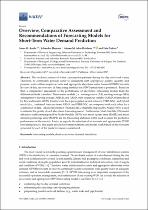 ResearchSpace
ResearchSpace
Overview, comparative assessment and recommendations of forecasting models for short-term water demand prediction
JavaScript is disabled for your browser. Some features of this site may not work without it.
- ResearchSpace
- →
- Research Publications/Outputs
- →
- Journal Articles
- →
- View Item
| dc.contributor.author |
Anele, AO

|
|
| dc.contributor.author |
Hamam, Y

|
|
| dc.contributor.author |
Abu-Mahfouz, Adnan MI

|
|
| dc.contributor.author |
Todini, E

|
|
| dc.date.accessioned | 2018-03-16T08:27:46Z | |
| dc.date.available | 2018-03-16T08:27:46Z | |
| dc.date.issued | 2017-11 | |
| dc.identifier.citation | Anele, A.O. et al. 2017. Overview, comparative assessment and recommendations of forecasting models for short-term water demand prediction. Watere, vol. 9(11): doi:10.3390/w9110887 | en_US |
| dc.identifier.issn | 2073-4441 | |
| dc.identifier.uri | doi:10.3390/w9110887 | |
| dc.identifier.uri | http://www.mdpi.com/2073-4441/9/11/887 | |
| dc.identifier.uri | http://hdl.handle.net/10204/10109 | |
| dc.description | Open access article published in Water, vol. 9(11): doi:10.3390/w9110887 | en_US |
| dc.description.abstract | The stochastic nature of water consumption patterns during the day and week varies. Therefore, to continually provide water to consumers with appropriate quality, quantity and pressure, water utilities require accurate and appropriate short-term water demand (STWD) forecasts. In view of this, an overview of forecasting methods for STWD prediction is presented. Based on that, a comparative assessment of the performance of alternative forecasting models from the different methods is studied. Times series models (i.e., autoregressive (AR), moving average (MA), autoregressive-moving average (ARMA), and ARMA with exogenous variable (ARMAX)) introduced by Box and Jenkins (1970), feed-forward back-propagation neural network (FFBP-NN), and hybrid model (i.e., combined forecasts from ARMA and FFBP-NN) are compared with each other for a common set of data. Akaike information criterion (AIC), originally proposed by Akaike (1974) is used to estimate the quality of each short-term forecasting model. Furthermore, Nash–Sutcliffe (NS) model efficiency coefficient proposed by Nash–Sutcliffe (1970), root mean square error (RMSE) and mean absolute percentage error (MAPE) are the forecasting statistical terms used to assess the predictive performance of the models. Lastly, as regards the selection of an accurate and appropriate STWD forecasting model, this paper provides recommendations and future work based on the forecasts generated by each of the predictive models considered. | en_US |
| dc.language.iso | en | en_US |
| dc.publisher | MDPI AG | en_US |
| dc.relation.ispartofseries | Worklist;20532 | |
| dc.subject | Forecasting models | en_US |
| dc.subject | Water demand simulation | en_US |
| dc.title | Overview, comparative assessment and recommendations of forecasting models for short-term water demand prediction | en_US |
| dc.type | Article | en_US |
| dc.identifier.apacitation | Anele, A., Hamam, Y., Abu-Mahfouz, A. M., & Todini, E. (2017). Overview, comparative assessment and recommendations of forecasting models for short-term water demand prediction. http://hdl.handle.net/10204/10109 | en_ZA |
| dc.identifier.chicagocitation | Anele, AO, Y Hamam, Adnan MI Abu-Mahfouz, and E Todini "Overview, comparative assessment and recommendations of forecasting models for short-term water demand prediction." (2017) http://hdl.handle.net/10204/10109 | en_ZA |
| dc.identifier.vancouvercitation | Anele A, Hamam Y, Abu-Mahfouz AM, Todini E. Overview, comparative assessment and recommendations of forecasting models for short-term water demand prediction. 2017; http://hdl.handle.net/10204/10109. | en_ZA |
| dc.identifier.ris | TY - Article AU - Anele, AO AU - Hamam, Y AU - Abu-Mahfouz, Adnan MI AU - Todini, E AB - The stochastic nature of water consumption patterns during the day and week varies. Therefore, to continually provide water to consumers with appropriate quality, quantity and pressure, water utilities require accurate and appropriate short-term water demand (STWD) forecasts. In view of this, an overview of forecasting methods for STWD prediction is presented. Based on that, a comparative assessment of the performance of alternative forecasting models from the different methods is studied. Times series models (i.e., autoregressive (AR), moving average (MA), autoregressive-moving average (ARMA), and ARMA with exogenous variable (ARMAX)) introduced by Box and Jenkins (1970), feed-forward back-propagation neural network (FFBP-NN), and hybrid model (i.e., combined forecasts from ARMA and FFBP-NN) are compared with each other for a common set of data. Akaike information criterion (AIC), originally proposed by Akaike (1974) is used to estimate the quality of each short-term forecasting model. Furthermore, Nash–Sutcliffe (NS) model efficiency coefficient proposed by Nash–Sutcliffe (1970), root mean square error (RMSE) and mean absolute percentage error (MAPE) are the forecasting statistical terms used to assess the predictive performance of the models. Lastly, as regards the selection of an accurate and appropriate STWD forecasting model, this paper provides recommendations and future work based on the forecasts generated by each of the predictive models considered. DA - 2017-11 DB - ResearchSpace DP - CSIR KW - Forecasting models KW - Water demand simulation LK - https://researchspace.csir.co.za PY - 2017 SM - 2073-4441 T1 - Overview, comparative assessment and recommendations of forecasting models for short-term water demand prediction TI - Overview, comparative assessment and recommendations of forecasting models for short-term water demand prediction UR - http://hdl.handle.net/10204/10109 ER - | en_ZA |





